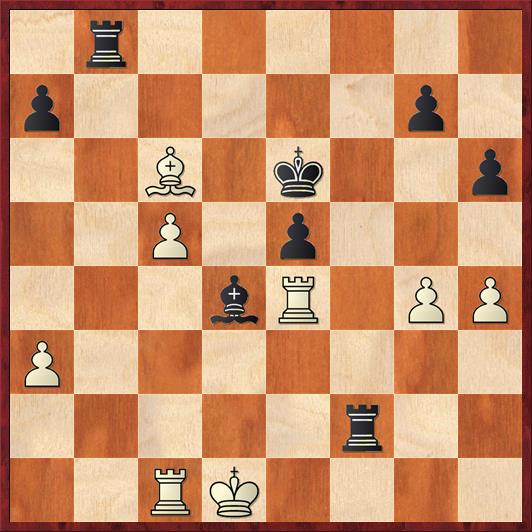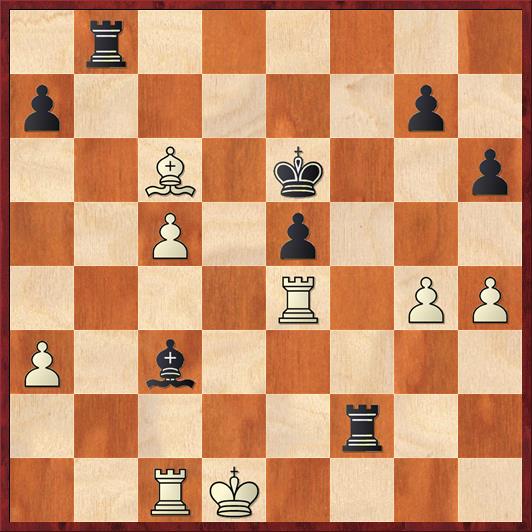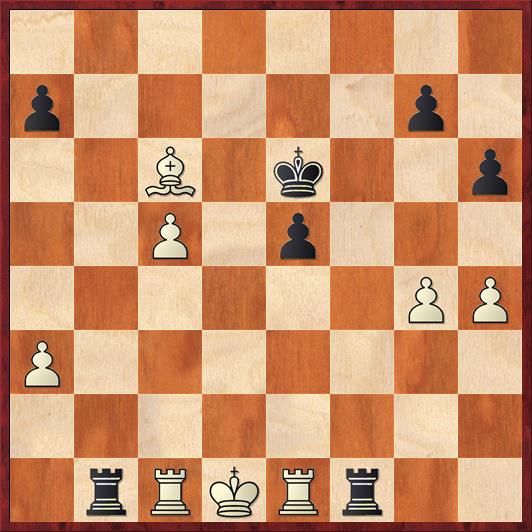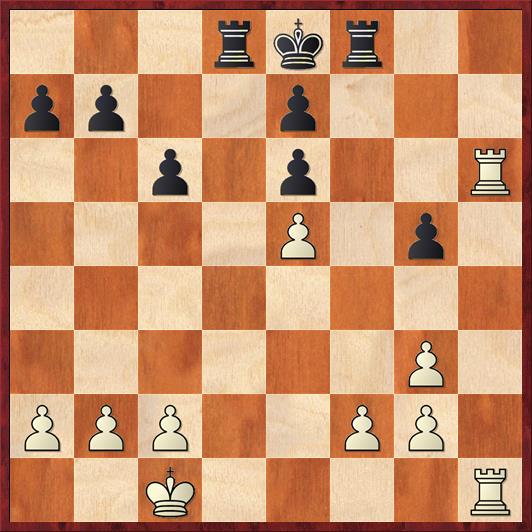I’ve got a new tactical trick for you! Of course, there is nothing new under the sun in chess, but this is a sneaky trick involving two rooks that I don’t think has ever been given a name before. (I hope someone will correct me if I’m wrong.) I’m going to call it the Van Damme Truck Trick, until somebody comes up with a better name.
Let me set the stage. Last night I was playing against Shredder, with its strength set at 2275. I know, a few months ago I swore never to do that again, because I was so infuriated at its “Coach” feature, where it tells you, “I think your last move was not so good. Are you sure you want to do that?” Well, in this game the Coach actually taught me something. I still hate it, because it destroys any semblance of real chess, but anyway, here is the position. I’m playing Black.
 Position after 40. Bc6. Black to move.
Position after 40. Bc6. Black to move.
FEN: 1r6/p5p1/2B1k2p/2P1p3/3bR1PP/P7/5r2/2RK4 b – – 0 40
As you can see, I have a wonderful position, and I played the move 40. … Rc8, which wins a pawn.
Shredder: “I think your last move was not so good. Are you sure you want to play it?”
Dana: What has that computer been smoking? Oh, I see! It thinks I should play 40. … Rd8, threatening checkmate.
Shredder: “I think your last move was not so good. Are you sure you want to play it?”
Dana: Okay, of course. On 40. … Rd8 it could just play 41. Ke1, and on 41. … R8f8 42. Bb5 what have I gained? Hmm… There must be something else in this position that I’m not seeing. It’s kind of a shame to take my rook off the b-file, where it’s already so well placed. Wait! I have an idea! I don’t even have to move the rook to c8! I can just take the pawn on c5 right away, with 40. … Bxc5!!
Shredder: “I think your last move was not so good. Are you sure you want to play it?”
Dana: Are you ****ing serious? 40. … Bxc5 is a brilliant move! That computer needs to be punished. Would turning it from a Mac into a PC be punishment enough?
Of course, there is a problem that after 40. … Bxc5 it doesn’t have to accept my sacrifice. It could just play 41. Ke1, and after 41. … Bb6 yes, I’ve won a pawn, but it’s only a pawn. Somehow there must be a way to get even more out of this idea.
And then the light dawned on me. Have you figured it out yet?
The absolute best move in the position is 40. … Bc3!!
 Position after 40. … Bc3!! White to move.
Position after 40. … Bc3!! White to move.
FEN: 1r6/p5p1/2B1k2p/2P1p3/4R1PP/P1b5/5r2/2RK4 w – – 0 41
The main point of this move, like 40. … Bxc5, is that it sets up the Van Damme Truck Trick. You remember the Volvo Truck commercial from 2013, when Jean-Claude Van Damme is standing on top of two trucks that are driving down a road, and they gradually move apart until Van Damme is doing a split between them at 60 miles an hour?
Well, here the White rooks are the trucks and the White king is Van Damme. After 41. Rxc3 (which Shredder played) Rb1+ 42. Rc1 Rf1+ 43. Re1 (which Shredder didn’t play) we arrive at the following amusing configuration.
 Position after 43. Re1 (analysis). Black to move.
Position after 43. Re1 (analysis). Black to move.
FEN: 8/p5p1/2B1k2p/2P1p3/6PP/P7/8/1rRKRr2 b – – 0 43
Here we see the point of the Van Damme Truck Trick. It looks as if White has successfully defended against both of Black’s rook checks. But now his king is like Van Damme doing a split between the two trucks — and if they move just a little bit too far apart, well, you can figure out what happens. 43. … Rxe1+! 44. Kxe1 Rxc1+ and White loses an exchange and a pawn and the game.
As I said, Shredder elected not to go into the pure version of the Van Damme Truck Trick and returned the rook immediately with 43. Kd2. I actually took the wrong way — 43. … Rbxc1? (43. … Rfxc1 was better) but I eventually managed to win the game anyway.
You might wonder, why was 40. … Bc3 better than 40. … Bxc5? The reason is that it’s more forcing. Black threatens mate with 41. … Rd8+, and White is forced to take the bishop one way or another. (He could alternatively play 42. Re2 Rd8+ 43. Kc2 Rxe2+ 44. Kxc3.) However, I really think that 40. … Bxc5 should get full credit too, provided that Black sees that 41. Ke1 can be met by 41. … Bxa3!, winning a second pawn. It’s really a matter of taste: do you prefer to be two pawns up in an OCB endgame, or do you prefer to be an exchange up? I think that the reason Shredder gave me the dreaded Coach message is that it evaluated the position after 40. … Bc3 as +4 pawns for Black, while the position after 40. … Bxc5 was only +2 pawns. Therefore it considered 40. … Bxc5 a bad blunder.
Anyway, to me the main point of the position is to see the Van Damme Truck Trick. Whether you set it up with 40. … Bxc5 or 40. … Bc3 is secondary.
Question for my readers: Do you know any examples of the Van Damme Truck Trick in master play? It’s one of those things that I know I’ve seen, but I don’t know where. I did lose a game a few years ago to a similar trick, but it’s not quite the same.
 Position after 21. Rxh6. Black to move.
Position after 21. Rxh6. Black to move.
FEN: 3rkr2/pp2p3/2p1p2R/4P1p1/8/6P1/PPP2PP1/2K4R b – – 0 21
This position occurred in the 2003 U.S. Open in Los Angeles. I was playing Black against a class-A player named Patrick McCartney. I think that I would have pretty close to equal chances after 21. … Rd5, thanks to my active rooks, but instead I got careless and played 21. … Rxf2??, thinking it was a free pawn. Too late, after he played 22. Rh8+!, I realized that I lose a whole rook after either 22. … Rf8 23. Rxf8+ Kxf8 24. Rh8+ or 22. … Kd7 23. Rd1+, and so I resigned. This trap does have elements of the Van Damme Truck trick in the sense that Black’s king gets checked from two different directions. Each check by itself is harmless, but the combination of the two is fatal.
Finally, if anyone can think of a better name than the Van Damme Truck Trick, I’d be glad to take suggestions. I’m looking for a metaphor that conveys the idea of being pulled in two directions at once.
I briefly thought about the Levi’s Jeans Trick, because their logo shows (or used to show?) a pair of jeans being pulled in two directions by two horses, as a way of emphasizing their toughness (the fabric is held together by rivets). But I didn’t like that name as well because I didn’t think anyone would get it. Another possibility is the Magdeburg hemispheres, a physics experiment designed by Otto von Guericke in the 1600s to prove the existence of the vacuum. He placed two copper hemispheres together, pumped out the air between them, and then a team of 24 horses pulling in opposite directions was unable to pull them apart. As wonderful as this example is, if I called this the Magdeburg trick no one would have the slightest idea what I was talking about. So for the time being, it’s the Van Damme Truck Trick.
Update, 2 hours later: Paul b. suggested the Three Stooges Trick. The king is Larry, and the rooks are Curly and Moe. Smack Curly on the left and Larry will look that way, and then you can whack Moe on the right. I like it!



{ 12 comments… read them below or add one }
Is there a way to put a diagram here?
Anyways, I saw something similar to that very recently on a Russian chess forum. Dana, you can understand that, so I’ll just give a link:
http://chesspro.ru/guestnew/looknullmessage/?themeid=24&id=1&page=14#24-1-2430
Hi Roman,
The link took me to the front page of the ChessPro forum, and there’s no easy way to tell where I should go from there. Can you tell me which thread the position was in?
I don’t know if it’s possible to upload a diagram to the comments of this blog, but an alternative possibility is to abbreviate the position in FEN notation (as I do for all of the diagrams in this blog). ChessBase can do this automatically, but it’s a little bit complicated to describe how.
It’s (transliterating where necessary) ChessPro -> Forum -> “Tvorchestvo Mass ” / Moi Partii -> “Gruzim” -> last page (15) -> post #435.
1r2r1k1/p5pp/2p5/3p4/4n3/4B2P/PPK2PP1/3R3R
1… Nf2 2. Bf2 Re2 3. Rd2 Rb2
6k1/p5pp/2p5/3p4/8/7P/PrKRrBP1/7R
Found it! This time the link took me straight there. I’m not sure why it took me to the front page last time. That’s a cute little combination. I like the comment at the end, too.
The Three Stooges trick. Smack Curly on the left; Larry in the center will look that way, then you smack Moe on the right.
Excellent! Is there any particular film where they did this, or was it just all the time?
Anyway, your name definitely gives the flavor of the trick better than my name did, and I will likely adopt the new name unless someone comes along with one that’s even better!
Call it Newton’s Cradle.
https://www.youtube.com/watch?v=JadO3RuOJGU
I like this name, too. Newton’s Cradle uses five balls, lined up just like the four rooks and the king in diagram 3.
Giving a type of chess position a name helps to categorize and catalog it in our minds, like pinning an insect to a display board. The human brain seems to be wired to want to do that.
Recently I’ve been working chess problems in Fritz 15 and I noticed that the more difficult ones often share a strange characteristic that I couldn’t identify and therefore I couldn’t stick a pin through it. Then it hit me that the positions were like a game that I played as a child. I couldn’t remember the name of the game so I googled “name of game where you slide tiles around” and there it was…
Wikipedia calls it “15 Puzzle”; it’s where you have a 4×4 box with 15 numbered tiles and one empty square and you have to move them into numbered order. The chess problems were similar – to mate, you have to force the king to slide around until you get him cornered. The 15 Puzzle is also known as a Magic Square puzzle, so now when I look at a chess problem I ask myself if the mate will involve a Magic Square trick. I’ve put a pin through this class of problems.
Yes, giving a name to something ratifies that its a *thing*. Once you’ve recognized it as a thing, you can look for it in other situations. The Hook and Ladder Trick was a very successful example. Once at Chesslecture.com Jesse Kraai showed how my lecture on the Hook and Ladder Trick helped him get his third grandmaster norm. He beat IM Vladimir Mezentsev with it, and it was all because Jesse knew it was a thing and was looking for it, but Mezentsev didn’t.
I’d be interested to see an example of one of the Fritz 15 problems that reminded you of Sam Loyd’s “15 Puzzle.” Could you give one of them in FEN notation?
Regarding the 15 puzzles there are Shinkman’s puzzles that involve shifting pieces in a way highly similar to the 15.
A friend of mine wrote a book about chess problems from various different angles, and he compares some series problems to the 15 puzzle. If you are interested, and have US$ 10 to spare, you can get it as an E-book from Gambit Books (http://gambitbooks.com/books/Problem_Chess.html). The kindle version has a preview of some 10 pages on Amazon if you want to check out the beginning of the book.
One of the problems in this section is this:
2bqk3/2rrp3/N7/8/B7/8/8/K7
It’s a series helpmate in 7 moves (ie, black moves seven times in a row, setting up a position where white can mate in one) by Viktor Bene, from 2008. It’s not very difficult; the mating patterns is fairly obvious, so you “only” have to block the squares that the white pieces don’t guard…
Another similar type of problems is proof games; Göran call them “the Rubik’s cube of chess problems”, which maybe indicates that they are “slightly” more intricate than the 15 puzzle type of chess problems. A (fairly) simple example is this classic:
rnbqkbnr/pp3ppp/2p1p3/8/4P3/8/PPPP1PPP/RNBQK1NR
(Tibor Orban, Die Schwalbe 1976)
Position after blacks 4th (!) move — what was the game?